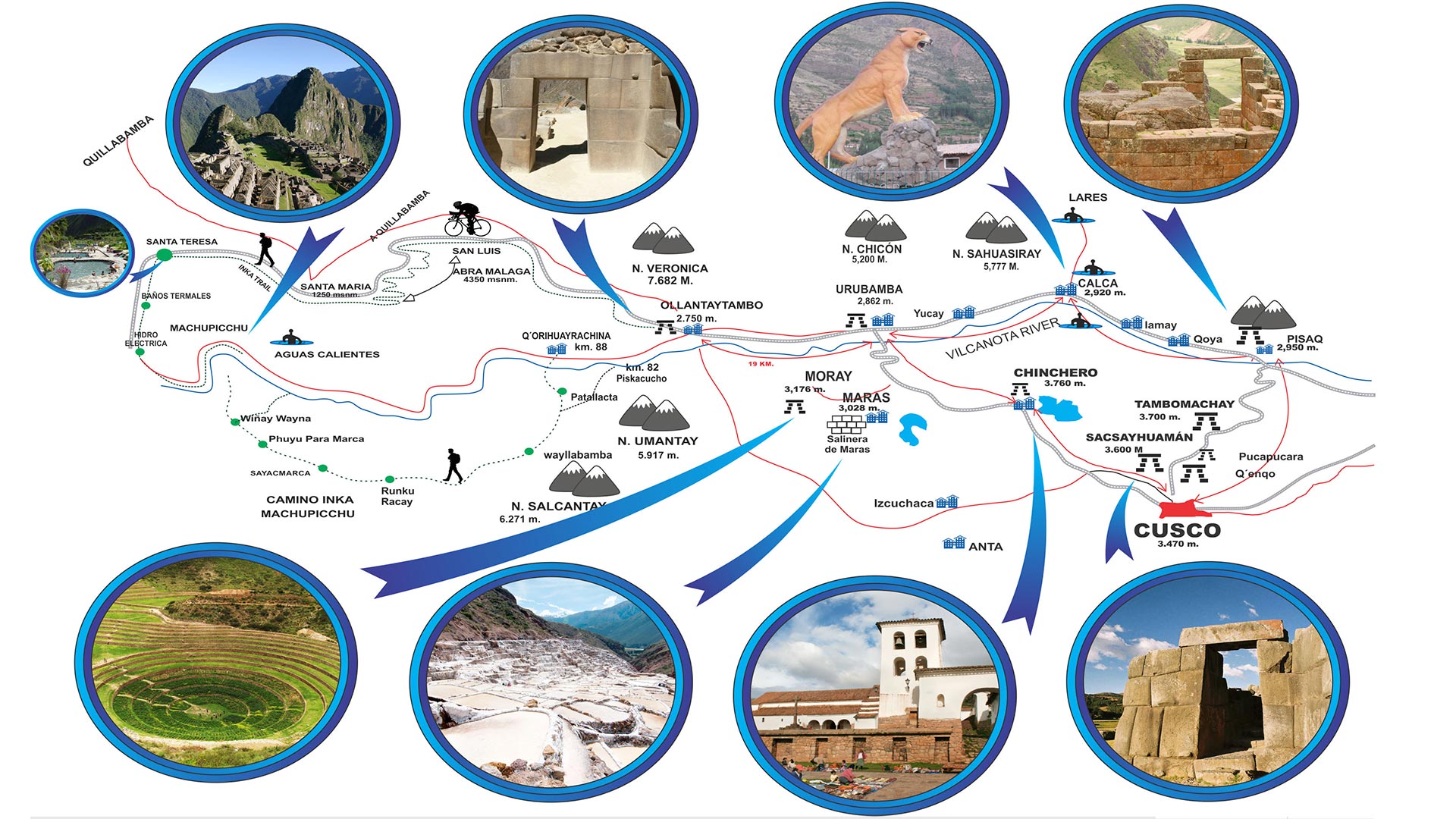Campers & Route Travelers
LIMA | ICA | NAZCA | ABANCAY | CUSCO | PUNO | AREQUIPA | MOQUEGUA| TACNA | PTO. MALDONADO
Route Map
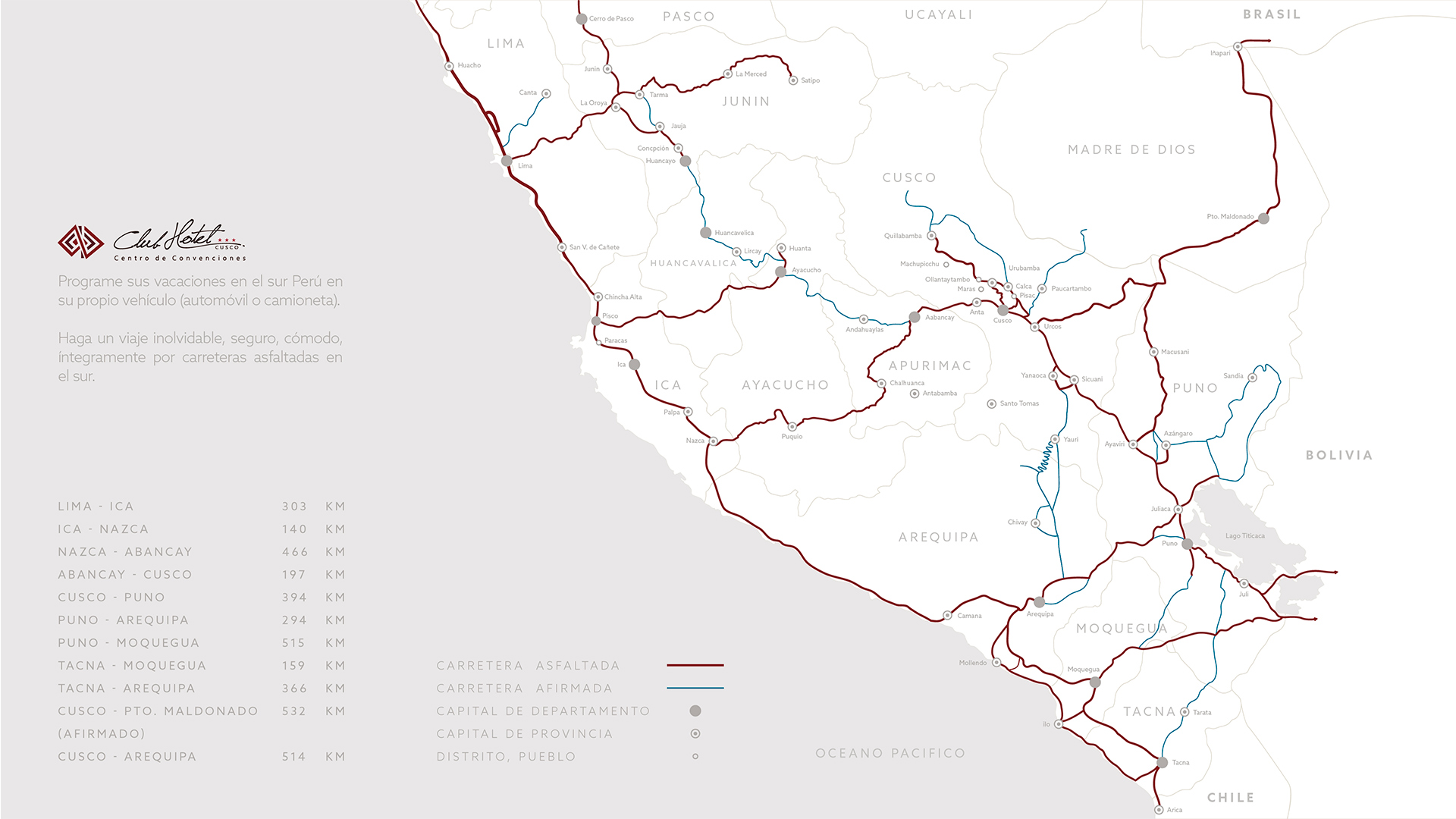
INFORMATION ABOUT CUSCO
Inca walls, colorful costumes, churches built on top of palaces, citadels lost in the Andean heights, legendary roads -all the beauty of a glorious past that enfolds the visitor who arrives in Cuzco, the sacred city of the Incas and archaeological capital of the Americas. Ever since USarchaeologist Hiram Bingham discovered the citadel of Machu Pichu for the world, Cuzco has fired the imagination of thousands of travelers from all over the world who venture down the Inca Trail every year headed for the summit of one of the world's most extraordinary monuments.
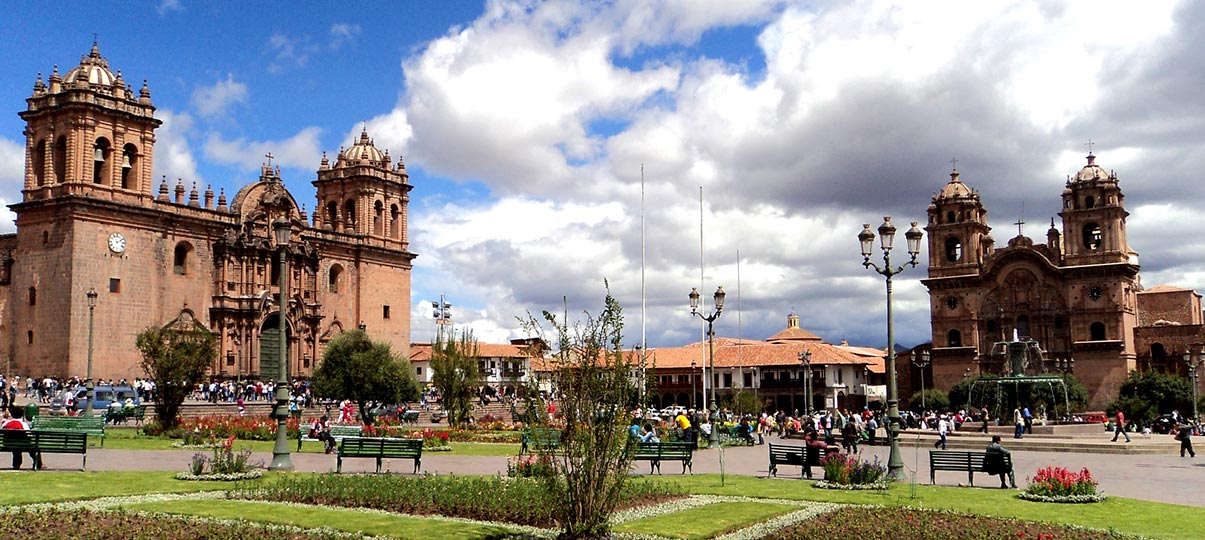
The city of Cuzco, however, features many other attractions which by themselves would be enough to attract visitors: the main square, which the Incas called Huacaypata, the artisans quarter of San Blas, the Convent of Santo Domingo, built on top of the Temple of the Sun or Korikancha, the palaces of the Inca and his court, part of a long list of archaeological wonders.
There are also several circuits on the outskirts of town, which usually include the imposing ruins of Sacsayhuaman or Tambomachay. Visitors can also take part in all kinds of adventure sports and participate in the most spectacular religious festivals on the continent. Celebrations include Qoyllur Rit´i, which is held at 4,000 meters, the Corpus Christi procession and the famous Inti Raymi spectacle.
With its bustling nightlife, Cuzco is also a magical city of dizzying excitement. Together with its rich archaeological legacy which is to be found on practically every street corner, its cultural scene makes the sacred city of the Incas the most spectacular destination in the Americas.Tourist Attractions of Cusco and surroundings
MAIN TOURIST ATTRACTIONS
Main Square. - Known as Huacaypata or the Warrior’s Square in Inca times, it was the scene of several key events in the history of Cusco. Each year, the spectacular Inti Raymi or Feast of the Sun took place there. Francisco Pizarro also proclaimed here the conquest of Cusco. With the arrival of the Spanish, the square was surrounded by a beautiful stone arcade, which embellishes the place until today.
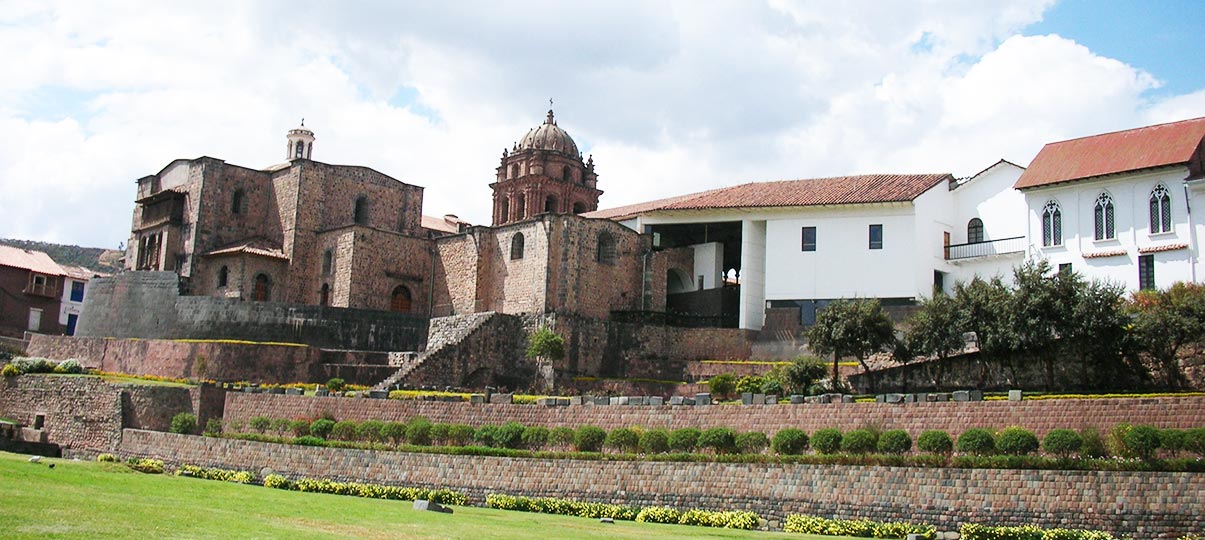
The Cathedral. - Located on the Main Square, it was originally built on top of the ancient temple of Suntur Wasi (God’s House). Today, it is the Church of El Triunfo. Later on, a new cathedral was built over what used to be the Palace of Inca Wiracocha. The façade and interior are of Renaissance style. The interior is decorated with wooden carvings on cedar and alder. The carvings of Martin Torres and Melchor Huamán are remarkable. Also important are the choir, pulpit, woodcarvings found on altars and furniture, as well as paintings of important artists and silver works.
Quarter of San Blas. - One of the most picturesque districts of Cusco. Known as the Artisans’ Quarter, it is the home of the most renowned artists of the city. Its narrow and steep streets shelter beautiful colonial buildings. Family lodgings open to tourists allow them to share the famous Andean hospitality and friendship, customs and meals.
Church of the Society of Jesus. - Located on the Main Square next to the Cathedral. Long ago, it was the Amaru Cancha (the Snake’s Fence), a palace that belonged to the Inca Huayna Cápac and a splendid stone building. One can see there several famous paintings, such as the wedding of San Ignatius of Loyola’s nephew with a native princess.
Church and Convent of La Merced. - Located in Portal Mantas, it was founded in 1536. The church’s tower is baroque stonework. Inside the sacristy, there is a gold monstrance decorated with precious stones.
Church and Convent of Saint Dominic. - Located in Plazoleta de Santo Domingo and Av. El Sol, this is a Spanish construction built on top of the Inca temple of Korikancha or Temple of the Sun.
Church and Convent of Saint Catherine. - The architecture of this church and convent belongs to the last phases of the Renaissance and includes Roman style stonework.
Church of San Blas. - Located in Plazoleta San Blas. It is the oldest parish of Cusco, in the Artisans’ district. An outstanding work is the wooden pulpit, the most extraordinary and artistic work of Spanish Churrigueresque style.
Church and Convent of Saint Francis. - Located in Plazoleta San Francisco. Inside the convent there is a monumental painting that is 39.3-ft. (12 m) x 29.5-ft. (9 m) and that relates the genealogy of the Franciscan family, painted by Juan Espinoza de los Monteros.
Archiepiscopal Palace. - Located in the corner of Hatun Rumiyoc and Herrajes St. This museum of religious art is a construction from viceregal times with Arabian influence, built over the foundations of Inca Roca’s palace.
Admiral’s Palace. - Located in Cuesta del Almirante 153 St., this is the Inca museum sheltering a huge variety of findings from around Cusco, such as: pottery, textiles, gold and silver works and mummies dating from Inca times.
House of the Four Sculptures. -. Located in San Agustín 259, this old house dates from viceregal times. The façade shows four sculptures, a coat-of-arms and a shield.
House of the Inca Garcilaso de la Vega. - Located in the corner of Heladeros St., it was the house of the renowned chronicler Inca Garcilaso de la Vega. It was built over an Inca terrace and is the perfect example of viceregal architecture. At present, it is the Regional Historic Museum. Paintings of the Cusco School of Art can be appreciated there.
Koricancha.- Located in El Sol and Santo Domingo St., this is a Dominican church and convent. The Koricancha (Quechua for gold zone) was the main religious building of the Incas used to worship the sun. According to the chroniclers, its interior walls were covered by gold plates. As can be seen, the construction of the sanctuary used, as its base, the magnificent blocks of stone finely carved by the Incas.
Acllawasi. - Located in Loreto St., it was the House of the Virgins of the Sun. This place was used as the residence of chosen women or Virgins of the Sun.
Amaru Cancha. - Located on the Main Square, this street was known before as Intiquijllu. It was the Inca Huayna Cápac’s residence. The area is partially occupied by the Church of the Society of Jesus and San Antonio Abad University.
Kiswar Kancha. - Located on the Main Square, next to the Church of the Society of Jesus. It was the residence of Inca Huiracocha’s.
Hatunrumiyoc. - Located two blocks away from the Main Square, it was Inca Roca’s residence. This is the place where the famous twelve angle stone is found and it is located on the street of the same name.
LOCATED IN THE OUTSKIRTS OF THE CITY
Sacsayhuamán. - Located 1.2 miles (2 Km) away from Cusco and about 10 minutes by car or 25 minutes walking from the city’s main square. It is an enormous construction of Inca times built as three platforms that are an average of 1,181 ft. (360 m) long. Stairs and stone doors connect the platforms. One of these doors is 30 ft. (9 m) high and 16 ft. (5 m) wide.
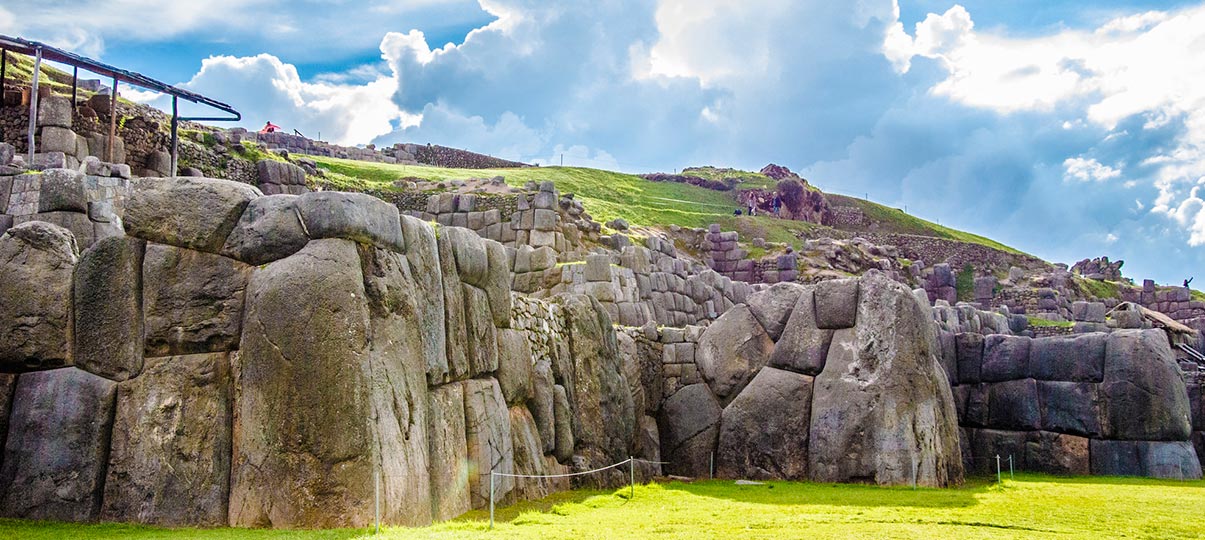
Kenko. - Located 1.8 miles (3 Km) away from Cusco and about 15 minutes by car from the city. It is thought to be a place of worship. There is a huge stone block of 19.3 ft. (5.9 m) high in the shape of a puma. There are also passages, channels and stairs with engravings representing animal shapes.
Puca Pucará. - Located 3.7 miles (6 Km) away from Cusco and about 30 minutes by car or 2 hours walking from the city. It was an administrative and military center formed by irrigation terraces, stairs, passages, towers and vaulted niches.
Tambomachay. - Located 4.3 miles (7 Km) away from Cusco and about 35 minutes by car from the city. Known as the Inca Baths, it is considered a place where water was worshipped.
SACRED VALLEY OF THE INCAS
Valley of the Urubamba or Vilcanota river. There you will be able to see:
Pisac: Picturesque town located 19.8 miles (32 Km) away from Cusco and about 1 hour by car. Its handicraft market is famous as well as its irrigation system, Inca astronomical observatory and irrigation terraces.
Yucay: Located 42 miles (68 Km) away from Cusco or about 1 and a half hours by car. It is a warm and beautiful fertile valley. The Palace of Inca Manco Sairy Túpac Segundo is important. It was an Inca agricultural center.
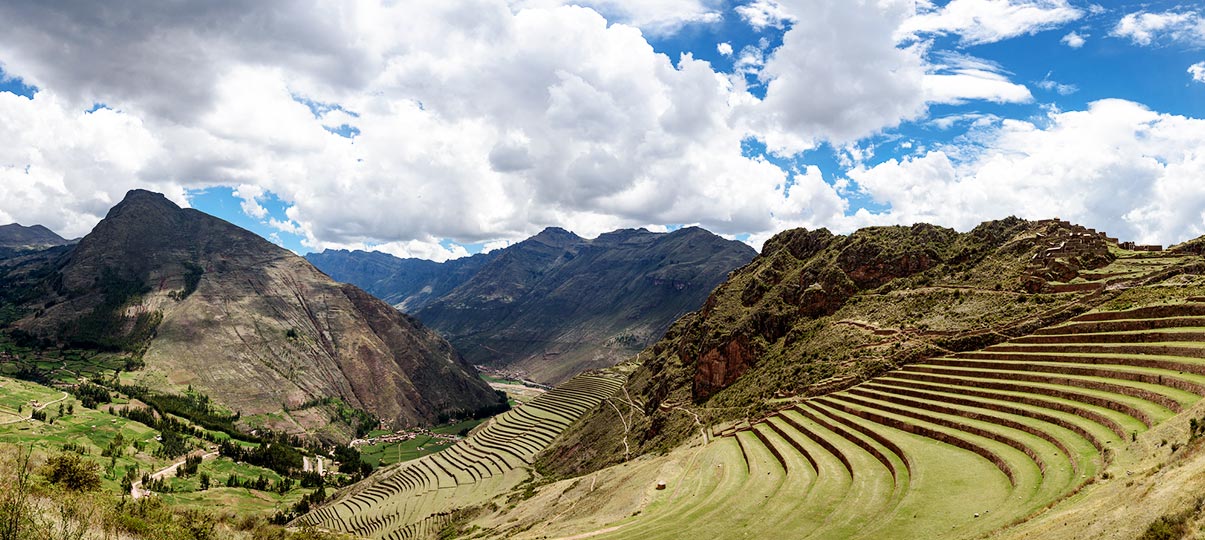
Calca: Located 31 miles (50 Km) away from Cusco and 1 hour by car. It has a beautiful landscape enhanced by two snowy mountains: the Pitusiray and the Sawasiray. In this province, there is the archaeological complex of Huchuy Qosqo, the thermo-medicinal baths of Machacancha (sulfurous thermal waters) and Minasmoqo (cold gaseous waters).
Urubamba: Located 48 miles (78 Km) away from Cusco via Pisac and about 1 hour and 25 minutes by car. The other route that can be taken is via Chinchero, 35 miles (57 Km) away and 45 minutes by car. The center of the Sacred Valley, this was an agricultural pre-Hispanic site. This fertile and comfortable zone offers the opportunity to stop for one night and make several excursions.
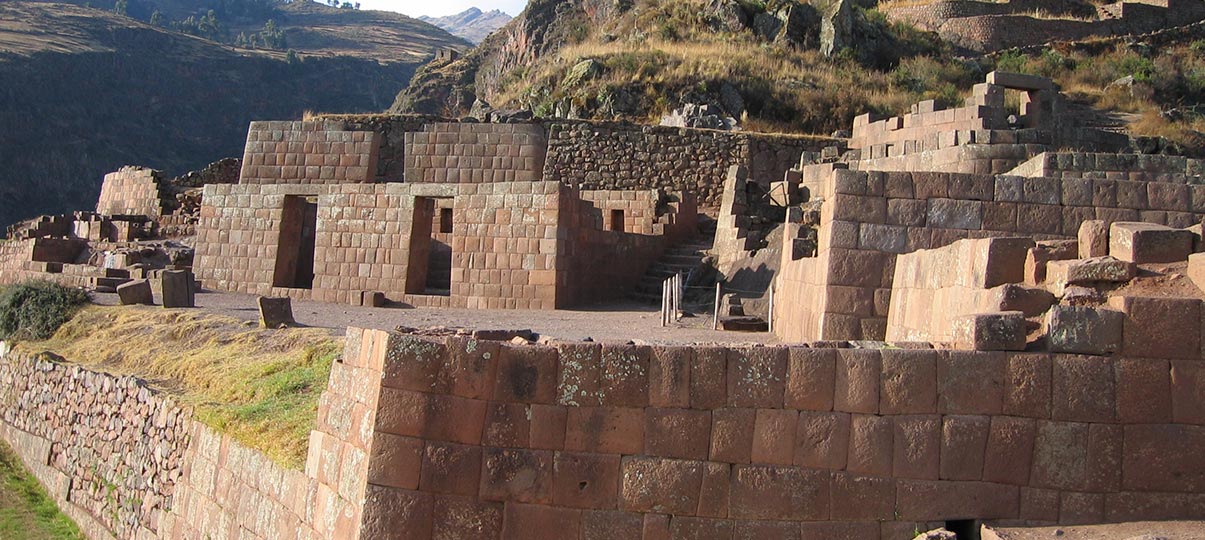
Ollantaytambo: Archaeological park 60 miles (97 Km) away from Cusco and about 2 and a half hours by car. The area of Ollantaytambo, also called Valley of Tambo, extends along the shores of the Vilcanota River up to Machu Picchu. A common feature is a multicolor cornfield. Inhabitants have designed a new tourism experience called Ancient Routes; visitors can walk around an Inca city learning about Inca hydraulics and agriculture.
Oropesa: Located 15 miles (24 Km) southwest of Cusco and 30 minutes by car from the city. It could be called the Land of Bread due to its numerous and ancient homemade ovens, where exquisite homemade bread is made.
Piquillacta: Located 19 miles (30 Km) south of Cusco and about 45 minutes by car from the city. There you will find the ruins of Wari (pre-Inca culture). The construction had defense purposes and was also used for the storage of agricultural products.
Andahuaylillas. - Located 24 miles (39 Km) south of Cusco and one hour by car from the city. This Church was founded in 1580. The façade is quite plain, making contrast with the expressive richness of the viceregal Baroque art found inside (golden altars, murals, paintings and polychrome ceilings).
CHINCHERO, MARAS CIRCUIT
Chinchero. - Located 17 miles (28 Km) away from Cusco and 12,447 ft. (3,772 m) above sea level, it is an archaeological Inca complex. It also has a colonial Church with paintings of the Cusco School of Art. On Sundays there is a typical market where barter takes place.
Maras. - Located 30 miles (48 Km) away from Cusco and about 1 hour by car. It was a very wealthy village during colonial times; the church and houses have Indian shields on their façades. In Maras, tourists can take part in the agricultural production and salt extraction processes, using the area’s ancient technology.
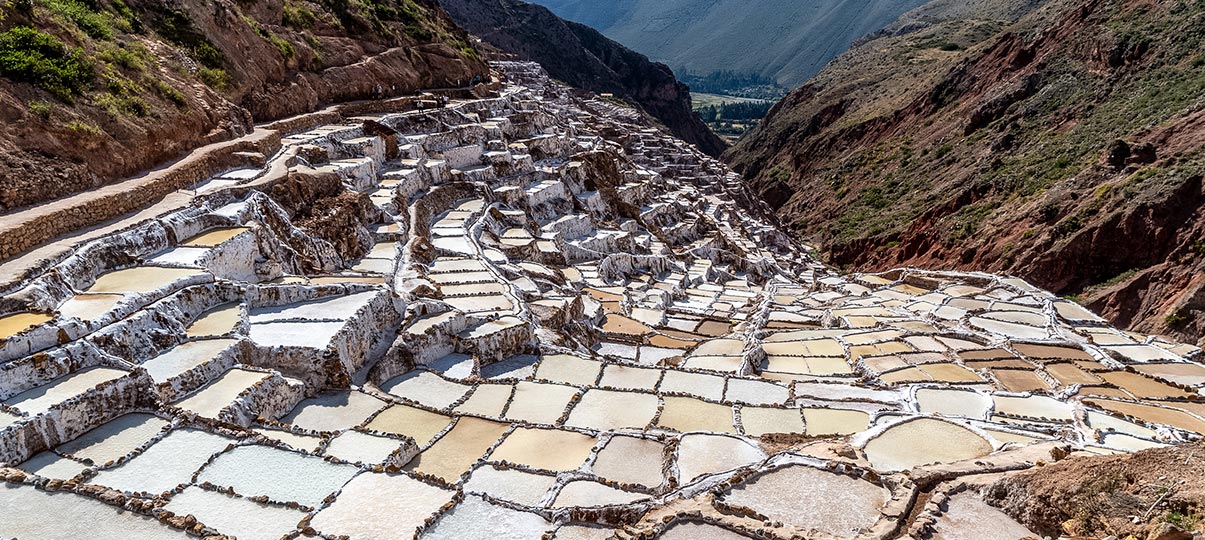
Moray. - Located 5.5 miles (9 Km) away from Maras and about 25 minutes by car. This place has elliptical irrigation terraces. It was an Inca agricultural experimental center.
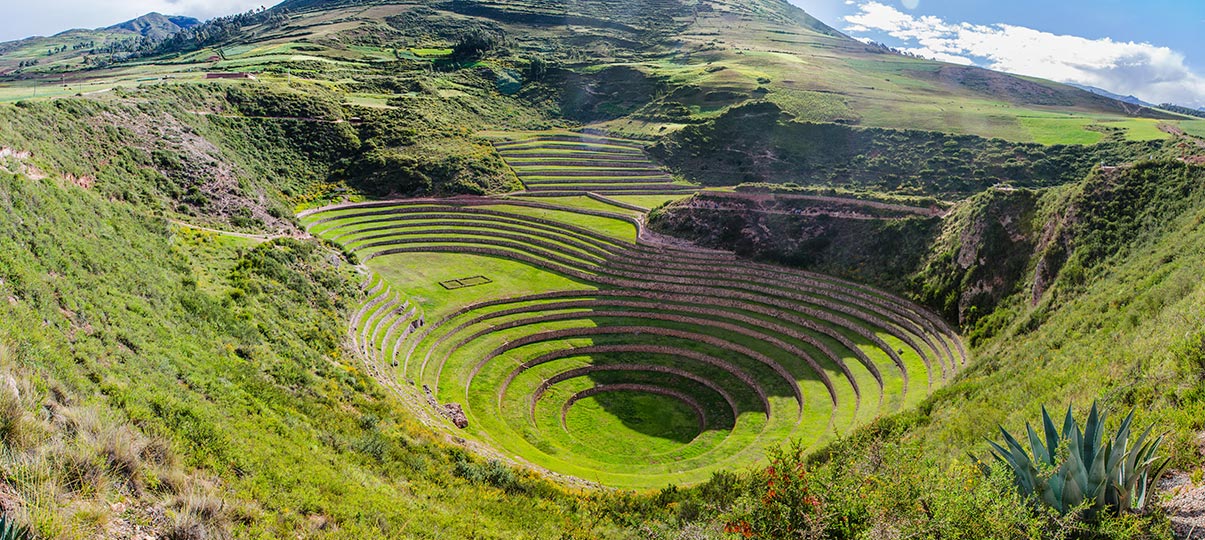
Salineras. - Located 6.2 miles (10 Km) away from Maras and about 30 minutes by car or 2 hours walking. Famous for its salt mines exploited from Inca times until today, it is worth visiting, due to the wonderful show of hundreds of salt ponds.
AGUAS CALIENTES AND MACHU PICCHU
MAIN TOURIST ATTRACTION
Historical Sanctuary of Machu Picchu
Visiting Hours: From Monday to Sunday, 6:00 to 17:30
With more than 35 thousand hectares, the Incan citadel of Machu Picchu is acknowledged as Cultural and Natural Heritage of the Humanity by UNESCO. It is known that the sanctuary has more than 300 species of birds and near 200 types of orchids recorded. There are different ways to access the citadel, both through the Camino Inca (Inca trail), which implies a route that may last hours or days- depending on the departure point- and by train or helicopter. The train journey lasts about four hours and includes appreciating a wonderful landscape.
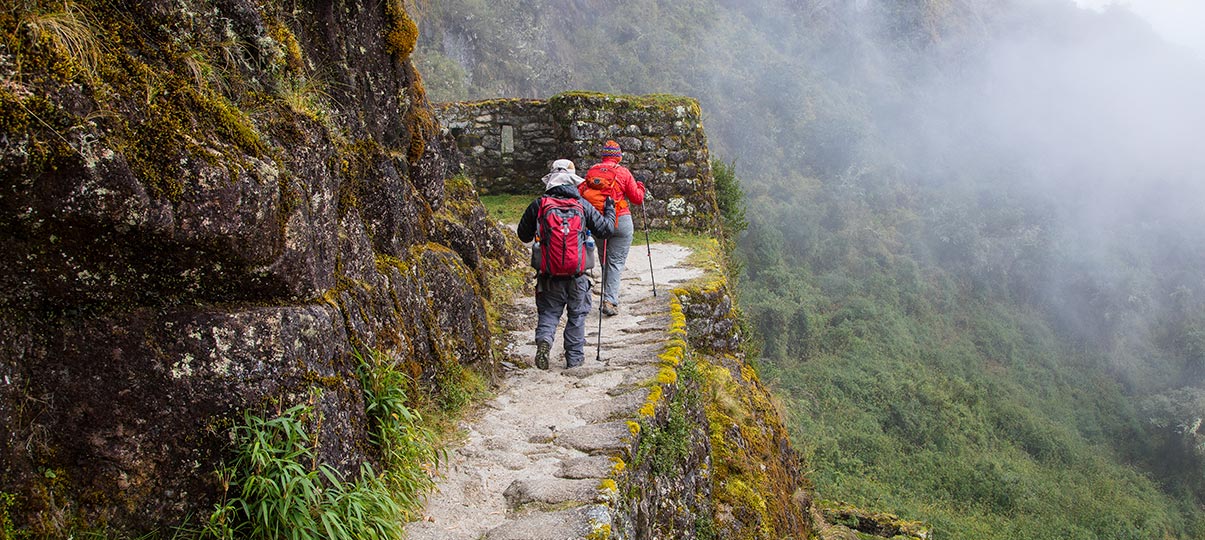
However, the train carriages do not have accessible restrooms. The fastest and most comfortable alternative is going by helicopter, which can be accessed from the Aeropuerto Internacional Velasco Astete.
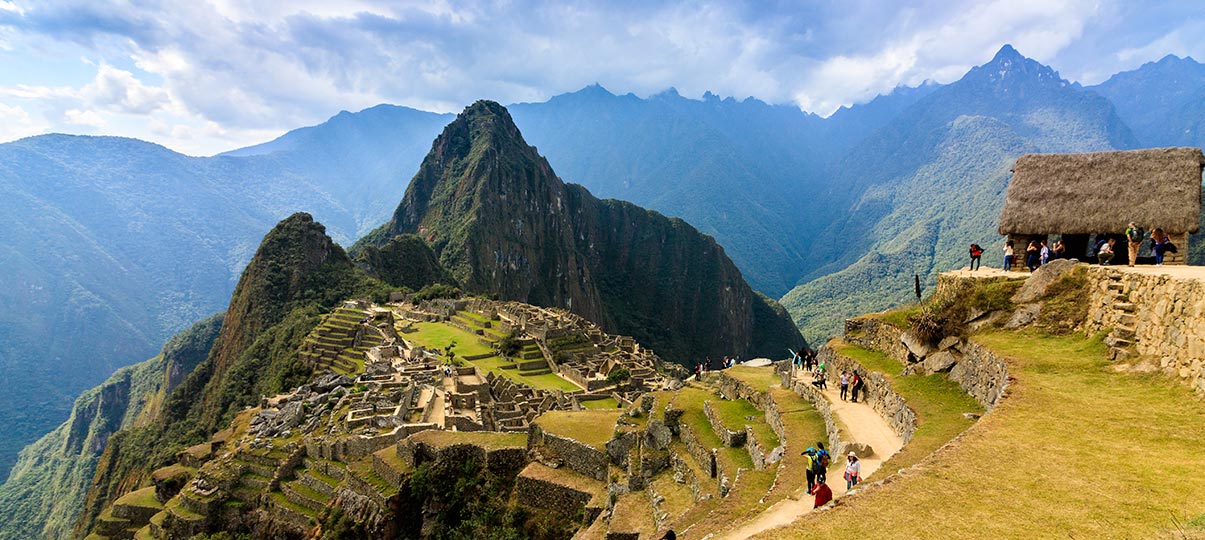
These two alternatives, train and helicopter, are complemented in Aguas Calientes with the service of buses, which travel through the Hiram Bingham road, named after the explorer that discovered the so-called "lost city" in 1911. Although the Historic Sanctuary of Macchu Picchu cannot be modified since it is Heritage of the Humanity, it is possible to go through great part of the place by means of the assistance of a duly qualified team of persons. Do not let the thirteen staircases leading to the ticket office discourage you, since many parts of the archaeological site are only accessible ascending numerous stone staircases. A considerable part of the route is facilitated by the existence of cultivation terraces, which are constructions with agricultural aims that belonged to ancient Peruvians.
One of the most amazing areas that can be visited with the assistance of trained personnel is the Temple of Three Windows, which offers a panoramic view of the place.
The ancient Inca citadel of Machu Picchu is the star attraction of Cuzco , the citadel is deemed one of the world's finest examples of landscape architecture.
It is split into two major areas: the agricultural zone, made up of terracing and food storehouses; and the urban zone, featuring the sacred sector, with temples, squares and royal tombs which have been carved to an extraordinary degree of perfection. The stone staircases and canals are found throughout this unique archaeological site. Over the citadel looms Huayna Picchu ("young mountain" in Quechua), which can be climbed up a steep stone-paved trail.
Located in the department of Cuzco , the Machu Picchu Historic Sanctuary protects unique species of flora and fauna, as well as featuring some breath-taking landscapes and preserving the archaeological sites to be found here. Much of the beauty and enchantment of Machu Picchu , Peru's premier tourist attraction, is due to its spectacular natural surroundings: the cloud forest region of this historic sanctuary.
Machu Picchu is home to some striking species, such as the cock-of-the-rocks ( Peru's national bird) and the spectacled bear, the only bear species in South America . The area is also inhabited by the rare dwarf deer called sachacabra and the Huemal deer, plus more than 300 bird species. The area boasts a large variety of flora species, with some 200 species of orchids registered here to date.
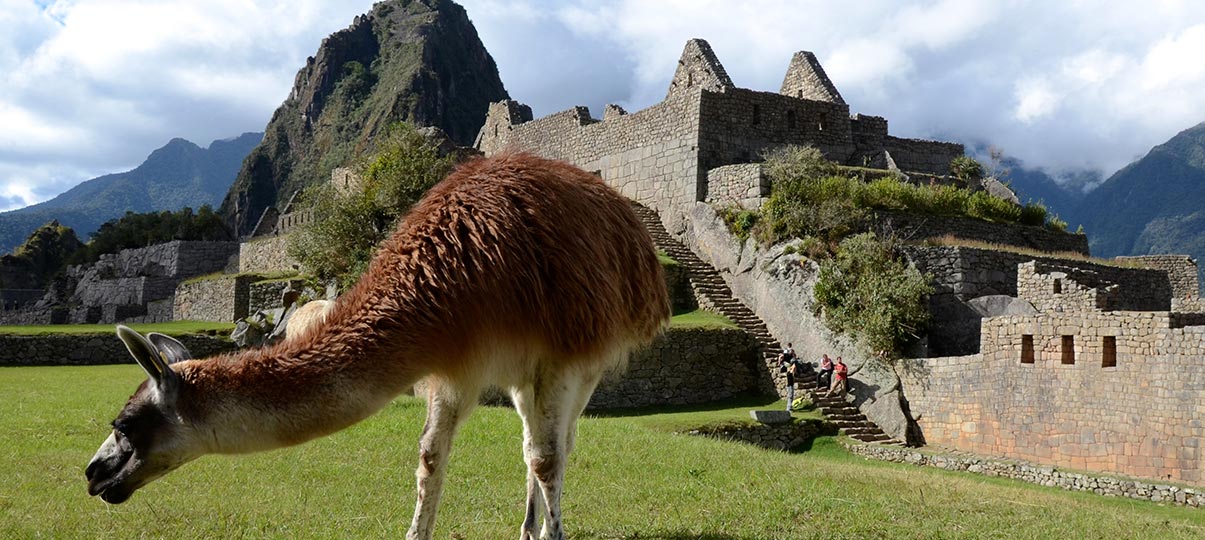
Towering over the area is Mount Salkantay ( 6,271 meters ), the highest mountain in the Cordillera Vilcanota range, worshipped by the locals as an apu mountain spirit. Machu Picchu combines a spectacular natural setting with the attraction of the world's most famous pre-Hispanic sites.
Machu Picchu "old mountain" in Quechua, the ancient language of the Incas) nestles on top of a mountain saddle high above the Urubamba River in the middle of the cloud forest. It was both a center of worship and astronomic observatory as well as the private retreat of the family of Inca ruler Pachacútec.
Machu Picchu [mA´chOO pEk´chOO] Pronunciation Key, Inca site in Peru , about 50 mi ( 80 km ) NW of Cuzco .
It is perched high upon a rock in a narrow saddle between two sharp mountain peaks and overlooks the Urubamba River 2,000 ft ( 600 m ) below. Ignored and later forgotten by Spanish colonial authorities because of its abandoned condition, the site was uncovered in 1911 by the American explorer Hiram Bingham. The imposing city is one of the largest pre-Columbian sites found virtually intact. It contains rare examples of religious monuments, including a carved stone (the Intiwatana), a small tower (the TorreOn ), and a cave with a masonry entrance (the Intimachay). Such indigenous shrines were generally destroyed by Spanish authorities. Perhaps the most spectacular ruin in the Americas . It shows admirable architectural design and execution, including a terracing system built on extremely steep terrain; it has been estimated that 60% of the effort expended on construction was devoted to creating the terraces. Archaeological and historical evidence indicates that it represents a mountain retreat of the Inca leader Pachacuti Yupanqui, who ruled c.1438–1471. Investigators have suggested the site may have served as a religious sanctuary and that the masonry windows at two of its monuments may have been aligned so as to define the June and December solstices. Experts do not agree whether the numerous steep walls at Machu Picchu and surrounding Inca sites were built as military fortifications or simply to delimit the boundaries of these special state installations.
"In the variety of its charms and the power of its spell, no place in the world which can compare with it. Not only has it great snow peaks looming above the clouds more than two miles overhead, gigantic precipices of many-colored granite rising sheer for thousands of feet above the foaming, glistening, roaring rapids; it has also, in striking contrast, orchids and tree ferns, the delectable beauty of luxurious vegetation, and the mysterious witchery of the jungle."
MACHU PICCHU is a citadel shrouded in mystery, and to this day archaeologists have not uncovered the history and purpose of this city of stone. The site that the Incas considered to be magical, due to the meeting of the Andes mountains with the mighty Amazon River .
Perhaps, MACHU PICCHU mystery may never be fully explained as, so far, there are only hypothesis and conjectures. For some, it may have been an advance settlement for planned further expansions by the Incas. Others believe MACHU PICCHU have been a monastery where young girls (Acllas) were trained to serve the Inca and the Willac Uno (High Priest). Support for this theory comes from the fact that of the 135 bodies discovered while exploring the site, 109 were female.
The surprising perfection and beauty of MACHU PICCHU's walls, built by joining stone to stone without using any cement or adhesive whatsoever, has led to many myths developing around how the city was constructed.
It is said that a bird by the name of Kak'aqllu knew the formula for softening rock but by command, perhaps, of the ancient Inca gods, had its tongue torn out. It is also said that there was a magic plant which could dissolve and compress stone.
Nonetheless, mysteries and myths aside, the real attractiveness of MACHU PICCHU , lies in its squares, aqueducts and watchtowers, its observatories and in its sun clock, evidence of the wisdom and skill of the city's Andean builders.
Machu Picchu is an indispensable place to visit for everybody who gets to Cusco , and on seeing it, you, like the famous North American archaeologist, will be left speechless and won't want to leave.
The urban sector is "U" shaped and has two immense architectural groups with streets and stairwells that consist of a total of 3,000 steps, as well as a network of water canals suitable for domestic and irrigation use, interspersed with small squares and courtyards.
The constructions in Machu Picchu have rectangular floor spaces. Many of the enclosures, called masmas, have only three walls, which at one time were all thatched with tree trunks and ichu (straw).
Doors and windows are encased in trapezoid shapes as are the niches in the walls where idols and other objects were placed; a typical feature of Inca architecture.
Each wall in Machu Picchu is different; even those that share the same enclosure have different styles. The best finished wall is the main wall of the Templo Principal ( Main Temple ), where the cut and polished stones are flawlessly fitted together.
Worthy of attention too are the Intihuatana, a sundial made out of polished stone; the Torreón (Watchtower), a building with curved walls.
Due to its special location in a region of Peru where the Andes and the Amazon meet, the citadel have been declared a protected area in order to preserve the flora, fauna and geological formations, as well as the archeological remains
Apart from Machu Picchu itself, there are 34 other archeological groups in the Sanctuary, which are interconnected by the ancient Inca Trail, an impressive original Inca route, which nowadays is open to tourists.
Notable amongst these sites are the Inca constructions of Runquracay, the ruins of Sacyamarca (similar to Machu Picchu ), the citadel of Phuyupatamarca ("Town above the Clouds"), the ruins of Wiñay Wayna ("Eternally Young"), the Temple of the Moon and the archeological group known as the Gran Caverna ("Great Cavern").
The flora of Machu Picchu is exuberant, and in higher areas different species of high-Andean grains are found. In the low areas, trees such as the "aliso" Alnus jorullensis, "nogal" Juglans neotropica, "intimpa" Podocarpus glomeratus, "Kisuar" Buddleja incana may be found. There are also 30 genuses.
There are species in danger of extinction in the Sanctuary as well, such as the "rock hen" ("gallito de las rocas"), the "spectacled bear" ("oso de anteojos"), the otter and the mountain cat.
Hotel and Lodging
As tourists have access to hotel facilities in Cusco city, a one-day visit to Machu Picchu is feasible. However, if the visitor wishes to stay overnight, the small town of Aguas Calientes, about 8 kilometers from Machu Picchu , has a good number of small hotels, hostels, and restaurants as well as standard facilities such as a police station, electricity, water supply and telephones.
For those taking the Inca Trail, there is a lodge very close to the ruins of Wiñay Wayna which has terraces and comfortable rooms.
Climate & Weather
From June to October the mornings are warm with brilliant sunshine, though it can get quite cool in the shade. At night temperatures can drop to 10ºC .
From December to April showers and downpours are common, followed by bright, intense sunshine.
We recommend taking a raincoat or umbrella to protect you from the rain.
Transportation
To get to Machu Picchu the visitor must travel by direct train from Cusco to Aguas Calientes and from there; board any of the buses provided by the six different agencies which cover the route up to the citadel.
Peru Rail offers a variety of services to Machu Picchu, from San Pedro Station, in Cusco, to Aguas Calientes.
CIRCUIT CUZCO MANU
Suggested length of stay: 8 days
This circuit combines the archaeological and cultural legacy of Cuzco with Peru's greatest natural treasure: the Manu National Park.
Visitors are advised to take the one-hour flight to Cuzco, where recent arrivals should rest up due to the high altitude. Cuzco is a unique example of the blend of native and colonial architecture, where visitors will find colonial constructions built on top of Inca foundations. The surrounding region also features many attractions: the town and church of Andahuaylillas, the Ollantaytambo fortress and the town of Pisac are just a few of the many attractions to be found in Cuzco, which are crowned by a visit to the citadel of Machu Picchu.
From Cuzco the road heads down to the Manu National Park, a journey that can take from 9-12 hours down to the villages of Atalaya and Shintuya, from where one continues by boat for another 5-6 hours. There are also 30-minute flights from Cuzco to Boca Manu, from where the boat ride takes 4-6 hours. The Manu teems with record numbers of species of plants, birds, insects, butterflies, mammals and reptiles, and is doted with an extraordinary diversity of eco-systems. The area is best visited from May to August. Visitors should bring insect repellent and sunblock.

CUSCO NIGHTLIFE
A real nightlife only developed in Cusco when the Tourist arrived. Towards the seventies, they opened the first night places for them: the "Abraxas" and the "Hatuchay" both in the Main Square. After some time the same people in Cusco, with the imagination encouraged by the stories going everywhere, decided to face the cold nights that had made them stay at home and realise that by night people are friendlier and it is easier for them to approach each other forgetting social, cultural and even languages differences.
We affirm that, in addition to the diverse attractions, Cusco can add to this list the intense, mad and cosmopolita nightlife with an original Andean touch. Enjoying its enchantments is a way of best knowing the Imperial City and compenetrate with its spirit. The following lines are the key you need to open the door and enter this world.
Music and Dances
Another good way of starting the night in Cusco is admiring the especial wealth and variety of the folklore of this region not only for its musical expressions but also for its dances. The traveler will have to choose between the "teatrines" (theatres) of some institutes that cultivate the folkloric art and an exclusive number of restaurants that offer this kind of shows.
A toast in the Sacred City
Being in Cusco without enjoying its wonderful urban beauty is a sin. This reality has been understood by the business people that have occupied all the places around the Main Square to open a pub, a bar or a café in the recent years. Each window on the second floor and every balcony have become into belvederes to enjoy the great square that at night with the lighted Cathedral and the "Compañia" acquires an enchantment even more overcoming.
The Pubs
The ideal place to start celebrating the night before going to dance. In general they stayed open after midnight and they offer the happy hour (drinks at half price) according to especial times they show at the entrance or at the bar.
Tecsecocha
Those people who prefer to spend a quitter night may choose to spend some hours in Tecsecocha: one of the few streets in Cusco, a stony street with balconies to its sides, that keeps the harmony of the place untouched. A place of a very different style waits for the visitor in this typical street of Cusco: the Couch bar "Los Perros". Its attractiveness is the informal atmosphere with sofas and couches displayed everywhere, people may even lie down to read a book or a magazine.
San Blas
Another suggested meeting point is San Blas. A typical square of noble Incas deserving to be considered one of the most beautiful places in Cusco. If walking by its streets at night could be dangerous, it is not drinking a coffee or a drink in one of the places located behind the church. At the Green's, the parish will find an intimate atmosphere thanks to the comfortable sofas and couches displayed around the center tables. On the other hand, the attraction of the Aule is its younger atmosphere especially its hillocks with cushions spread on the floor around a low table where you find many books.
The discotheques
Around midnight, cafes and pubs are ready to close their doors. It is time to go to disco-bars that especially at that time start with all the enthusiasm that lasts till the sunrise.
OTHER ACTIVITIES
You can also indulge in a wide range of activities in the area, including mountain biking, whitewater rafting and, for those who prefer a little less physical exertion, fishing and horse riding.
Lake & River Fishing
There are many ideal locations in the Sacred Valley and Puno for lake fishing, and Rio Vilcanota is a good area for river fishing.
Please contact our tour operator on arrival to find out about fishing locations and excursions.
Horseback Riding
The area surrounding Cusco is a wonderful setting for Horseback riding.
Rides to the archaeological park area include Sacsayhuamán, Kenko and other important ruins, all the way to the district of Corao. The SacredValley is also an ideal location for riding.
Day excursions are available.
To find out more or to organize an excursion, please contact the hotel
Mysticism
Peru's folk healers draw on their knowledge of the past to cure their patients in ceremonies imbued with a mixture of traditional medicine, Catholicism and natural plant extracts, such as the San Pedro cactus.
Weaving
Contemporary Andean weavers are heirs to a rich textile repertoire that goes back thousands of years. Weaving workshops, lectures by weavers and textile experts, and visits to Peru's leading collections of ancient textiles can be arranged.
Archaeology
The pre-Inca and Inca cultures of Peru created some of the most stunning artwork and monuments known to mankind. Visit Peru's major archaeological museums, slide lectures and visits to excavations in process, when possible.
Ecotourism
Visit some of the best ecotourism destinations in areas like the pristine rainforests of Puerto Maldonado or the canopy walkway near Iquitos.
Agriculture
Tailor-made agriculture programmes can be arranged for specialised groups interested in the different variety of products exported to other countries, such as cotton, asparagus, mangoes, lucuma, etc.
Birdwatching
Because of its tropical location and its large number of ecosystems, Peru is a birdwatcher's paradise. Customised birdwatching tours can be arranged.
Botany
Roughly 35,000 species of plants exist in the Peruvian territory; over 20,000 have been identified and the rest are endemic.
Tourist Circuit of the Sacred Valley
